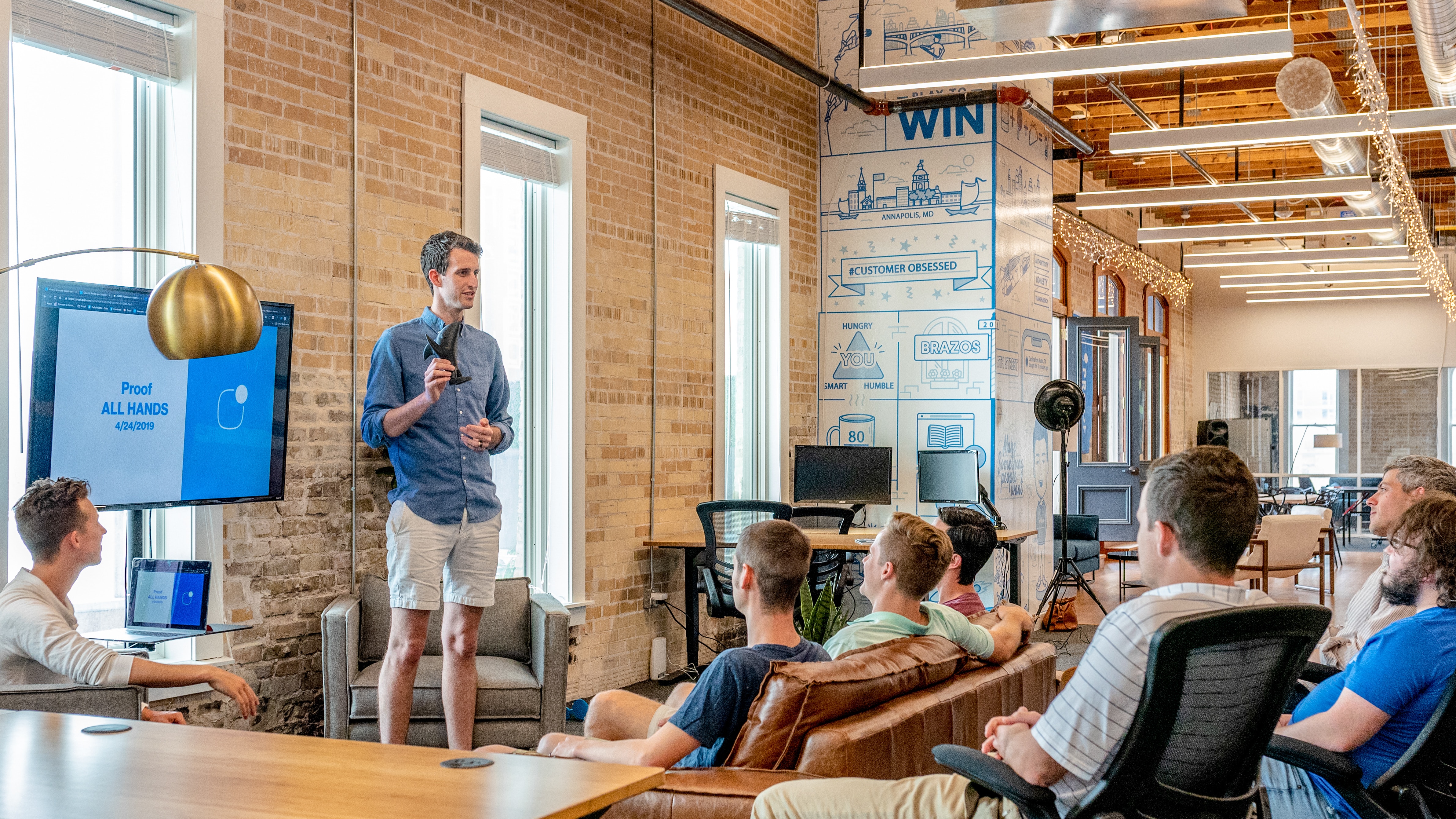Overturning a Man’s World: How Coworking Supports Women

Photo credit: Elena Mishlanova via Unsplash
In business leader Sheryl Sandberg’s bestselling book Lean In, she recollects a time when she was pregnant and couldn’t find a vacant parking space near the entrance of the Google headquarters where she worked. Sandberg requested her male employers immediately implement “designated parking for expectant mothers at the front of each building,” but she wouldn’t have been the first pregnant woman working at Google. She wondered whether her female coworkers hadn't felt comfortable calling it out.
Women have historically been underrepresented in the workplace. This was cleverly depicted in this summer’s phenomenal Barbie film when manufacturer headquarters Mattel had a clear absence of women working at the top. For a company that was originated by a woman, making products for women, it seems unbelievable. Sadly this representation isn’t a million miles off what the corporate world used to look like (as Sandberg can attest). The needs of women at work are commonly overlooked in a male-dominated world.

Photo credit: Austin Distel via unsplash
Coworking, it’s a man’s world…
When coworking entered the working realm well over a decade ago, the playful look, feel, and culture of coworking set it apart from traditional corporate offices. It brought an expectation that coworking was reversing notions of the patriarchal corporate world. This was reflected in its workspace design, an example being the “Superdesk” – a long, curved desk to seat 175 people designed by Clive Wilson. A round table is representative of inclusivity.
But then the beer tap came along. Free unlimited alcohol on demand allows workers to tap out of a stressful work day and enjoy one or two drinks before leaving the office. Its unlimited source, however, encourages more than one or two. Excessive drinking is problematic and led certain coworking spaces to become synonymous with “bro culture.” The beer tap was a symbol of patriarchy at work if ever there was one. A notable workspace operator has experienced multiple incidents of sexual harassment and assault as a result of an unlimited supply of alcohol on demand.
It also begs the question – Were women ever involved in the design processes of those shared workspaces? Possibly not. That’s where the problem lies. Not listening to the requirements of women contributes to a world that’s designed by men, for men. “The blunt truth is men still run the world. This means that when it comes to making the decisions that most affect us all, women’s voices are not heard equally,” expresses Sandberg.
A coworking space isn’t going to be used by women if we don’t feel it’s designed for us. To create inclusive workspaces for women, operators must listen and understand what women want (pun intended).
Steps into our shoes
Shazia Mustafa is the Centre Director for the Granville – an affordable workspace for the South Kilburn community, and co-founder of Third Door – the UK’s first coworking and flexible nursery hybrid Ofsted registered business. Discussing diversity, equity, and inclusion in coworking at the Workspace Design show earlier this year, Mustafa recommended that operators who are designing workspaces inclusive of women start with bathrooms.
“Toilets are important,” she says, and bear in mind that women feel the cold at a lower temperature than men. The average temperatures of AC units are set to male preferences (the first air conditioning unit was designed in 1902 by US engineer Willis Haviland Carrier). In her revolutionary book Invisible Women, feminist writer Caroline Criado Perez explains that women are “shivering in offices set to a male temperature norm, for example, or reaching a top shelf set at a male height norm.” Her book continues to expose a significant gender data gap that’s exemplified by the size of your phone, the design of your uniform, workplace safety regulations, and many more.
Mustafa says: “When I set my coworking space up for working parents, it was 2008 before anyone knew what coworking was. I set it up from the viewpoint of a mum.” Similar to Sandberg’s experience at Google, Mustafa faced new challenges when becoming a mother. She recollected how even walking around London became much more challenging when using a pram. She then became aware that people with disabilities must also struggle to navigate the city. Sometimes, it’s only when we have first-hand experience that we truly understand the needs of others. That’s why it’s so important to involve women in the design process. You can design a workspace around our needs, one which instantly is more inclusive of, and more usable for and by women.

Photo credit: Sandy Millar via Unsplash
Women in flex
It’s important to think about women at all life stages too, as women who are just entering the workforce will have different needs than mothers, menopausal women, or older women who struggle with their mobility, for example. Applying a one-size-fits-all approach doesn’t work. Staying flexible does. By its very nature, coworking is flex. It embraces flexible working lifestyles. That’s why there’s no fixed agenda, no mandated start time, or clocking in how many coworkers walk through the doors. It’s completely up to individuals to decide when they’d like to use it. This approach works for many companies. Last year, 12% of UK businesses were seeking coworking spaces over leasing their own private offices, reports Mordor Intelligence.
The coworking industry expects to see an 8% compound annual growth rate between 2022-2027. It’s a shift that most people welcome, especially women. “Female employees who are able to work how they want are less burned out, happier in their jobs, and much less likely to consider leaving their companies,” reveals the findings of the Workplace Health Report 2023 on the mental health of the UK workforce.
Its research also discovered that only 1 in 10 women actually want to go into the office. They’re attracted to organisations that support remote working, which might be because women are typically the default caregiver for their children and elderly parents. Commuting for 90 minutes a day (the average commute time) becomes impossible for women with fragmented time. Meanwhile, a local workspace gives parents an opportunity to leave home but be right around the corner if they need to pop back.
Local workspaces are one of several coworking industry trends in high demand by women, amongst other intersectionalities. This is important too - there are many more needs to consider when creating inclusive workspaces. Nonetheless, putting your community’s needs first empowers them to thrive in your workspace, as well as attracting them in the first place. By hearing their voices, meeting their requirements, and designing a workspace for them, you’re creating truly inclusive coworking communities.
And if you’re not convinced that it’s still a man’s world, I suggest you go and watch the Barbie movie!
If you’re thinking of opening a coworking space and are looking for a software solution to streamline processes, book a demo today.
Related stories
Connection, Belonging, Identity: Why Branding Matters When You’re Building Your Community
Guided by industry insights, we navigate the intricate landscape of branding, probing fundamental questions posed by thought leaders like Cat Johnson. Beyond logos and colour schemes, we uncover the essence of brand identity.
Elevating mixed-use spaces: The crucial role of hospitality and technology in community management
As mixed-use developments continue to grow in popularity, merging visitors with locals through a high level of hospitality, and community, in whatever way the space functions, is of prime importance.
The glorious renaissance of community-led coworking
Join us in exploring how the coworking movement transcends beyond just providing desks and chairs- it's a catalyst for community and collaboration.
3 Things People Want From Their Workplace Experience
According to Appspace’s 2023 Workplace Experience Trends & Insights Report, 93% of people who work in an office think their organisation could do more to improve the workplace experience. To craft a truly exceptional workplace experience, it’s useful to know what people are actually looking for in an office environment – which, of course, can change over time. So, we decided to do a little digging.
Overturning a Man’s World: How Coworking Supports Women - Part 2
In this follow-up to the recent blog post, Overturning a Man’s World, we continue an exploration of how coworking supports women.
Building an Inclusive Workplace Experience at Huckletree
Huckletree, a longstanding customer of Nexudus, has a growing network of shared workspaces across the UK and Ireland. It represents a community of over 4,000 people working across dynamic tech and creative sectors including web3, fintech, AI, govtech, and sustainable innovation.
How To Make Your Coworking Software Work For Your Brand
With so many new and interesting coworking offerings emerging, it’s never been more vital for existing spaces to differentiate themselves and stand out. And one of the best ways to achieve this is by establishing a strong brand presence.
Behind The Desk: Meet Our Founders
Welcome to, where we dive deep into the brains behind Nexudus. Today, we’re chatting with Nexudus’ CTO and co-founder Adrian, as he shares his journey from selling Internet Cafe technology to being the co-founder of a global coworking company.
Creating Future-Ready Workspaces with Nexudus' Experts 🌍
We sat down with Stephen Wood, Nexudus’ North America Account Lead and our North American technology partner, Serge Rose, to talk about their recent collaboration in assisting a Canadian client with their migration to Nexudus and to delve into their thoughts on the future of technology in workspaces moving forward!
Strengthening our US Presence: An Intro to our Growing Stateside Nexudus Team 🌳
Our US team recently moved into a new coworking location in Las Vegas, and we grabbed the opportunity to catch up with the team, get some insights into their roles from the other side of the pond at the world-famous entertainment capital!

